Related Research Articles
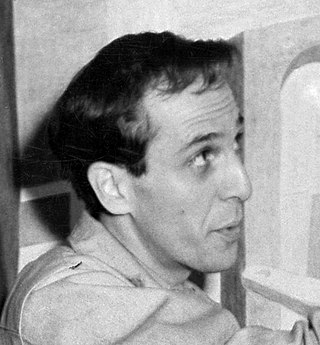
Philip Guston was a Canadian American painter, printmaker, muralist and draftsman. "Guston worked in a number of artistic modes, from Renaissance-inspired figuration to formally accomplished abstraction," and is now regarded as one of the "most important, powerful, and influential American painters of the last 100 years". He frequently depicted racism, antisemitism, fascism and American identity, as well as—especially in his later most cartoonish and mocking work—the banality of evil. In 2013, Guston's painting To Fellini set an auction record at Christie's when it sold for US$25.8 million.

John Anthony Baldessari was an American conceptual artist known for his work featuring found photography and appropriated images. He lived and worked in Santa Monica and Venice, California.
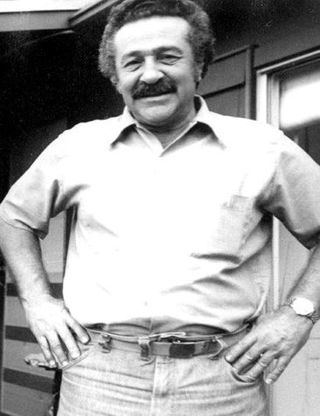
Nathan Oliveira was an American painter, printmaker, and sculptor, born in Oakland, California to immigrant Portuguese parents. Since the late 1950s, Oliveira has been the subject of nearly one hundred solo exhibitions, in addition to having been included in hundreds of group exhibitions in important museums and galleries worldwide. He taught studio art for several decades in California, beginning in the early 1950s, when he taught at the California College of Arts and Crafts in Oakland. After serving as a Visiting Artist at several universities, he became a Professor of Studio Art at Stanford University.
The Bay Area Figurative Movement was a mid-20th-century art movement made up of a group of artists in the San Francisco Bay Area who abandoned working in the prevailing style of Abstract Expressionism in favor of a return to figuration in painting during the 1950s and onward into the 1960s.
Leo Braudy is University Professor and Professor of English at the University of Southern California, where he teaches 17th- and 18th-century English literature, film history and criticism, and American culture. He has previously taught at Yale, Columbia, and Johns Hopkins University. He is best known for his cultural studies scholarship on celebrity, masculinity, and film, and is frequently sought after for interviews on popular culture, Hollywood cinema, and the American zeitgeist of the 1950s.
David Hilliard is an American photographer. A fine arts photographer who works mainly with panoramic photographs, he draws inspiration from his personal life and those around him for his subject matter. Many of the scenes are staged, evoking a performative quality, a middle ground between fact and fiction.

Jack Zajac is a Californian West Coast artist who has been concerned with the “Romantic Surrealist tradition”.
Kerry James Marshall is an American artist and professor, known for his paintings of Black figures. He previously taught painting at the School of Art and Design at the University of Illinois at Chicago. In 2017, Marshall was included on the annual Time 100 list of the most influential people in the world. He was born and raised in Birmingham, Alabama, and moved in childhood to South Central Los Angeles. He has spent much of his career in Chicago, Illinois.
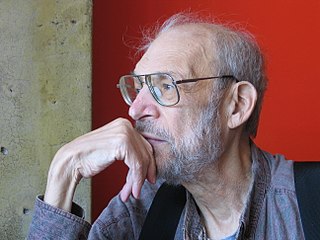
Albert Boime, was an American art historian and author of more than 20 art history books and numerous academic articles. He was a professor of art history at the University of California, Los Angeles, for three decades, until his death.

Kenneth Hayes Miller was an American painter, printmaker, and teacher.
California Tonalism was art movement that existed in California from circa 1890 to 1920. Tonalist are usually intimate works, painted with a limited palette. Tonalist paintings are softly expressive, suggestive rather than detailed, often depicting the landscape at twilight or evening, when there is an absence of contrast. Tonalist paintings could also be figurative, but in them, the figure was usually out of doors or in an interior in a low-key setting with little detail.
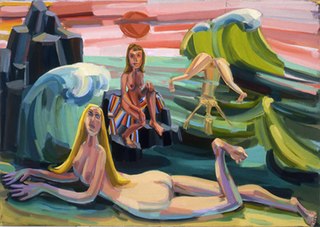
Judith Linhares is an American painter, known for her vibrant, expressive figurative and narrative paintings. She came of age and gained recognition in the Bay Area culture of the 1960s and 1970s and has been based in New York City since 1980. Curator Marcia Tucker featured her in the influential New Museum show, "'Bad' Painting" (1978), and in the 1984 Venice Biennale show, "Paradise Lost/Paradise Regained: American Visions of the New Decade." Linhares synthesizes influences including Expressionism, Bay Area Figuration, Mexican modern art and second-wave feminism, in work that flirts with abstraction and balances visionary personal imagery, expressive intensity, and pictorial rigor. Art historian Whitney Chadwick wrote, "Linhares is an artist for whom painting has always mattered as the surest path of synthesizing experience and interior life," her works "emerging as if by magic from an alchemical stew of vivid complementary hues and muted tonalities." Critic John Yau describes her paintings "funny, strange, and disconcerting," while writer Susan Morgan called them "unexpected and indelible" images exploring "an oddly sublime territory where exuberant bliss remains inseparable from ominous danger."

Deepak Shimkhada is a Nepalese-American with a diverse professional background, including work as an Asian art historian, educator, writer, editor, and painter. He currently serves as an adjunct professor at Chaffey College in Rancho Cucamonga, California, and has previously held visiting and adjunct positions at several U.S. universities, including Scripps College, Claremont Graduate University, California State University, Northridge, University of the West, and Claremont School of Theology. His teaching career began in 1980, and while he has retired from full-time teaching, he continues to teach Asian art part-time at Chaffey College.
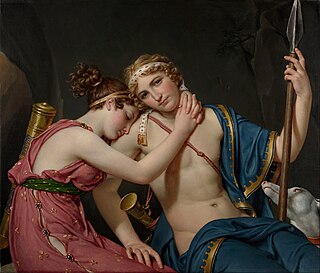
The Farewell of Telemachus and Eucharis is a painting from 1818 by Jacques-Louis David, now in the J. Paul Getty Museum in Los Angeles, California. Painted during David's exile in Brussels, it was purchased by the Count von Schönborn-Wiesentheid. It depicts Telemachus and Eucharis, two characters in François Fénelon's 1699 novel Les Aventures de Télémaque, inspired by Homer's Odyssey. The artist's last painting of a couple from mythology, it is a pendant painting to his Love and Psyche.
Holly Roberts is an American visual artist known best for her combination of photography and paint. “Holly Roberts caused a stir in the fine art photography world of the eighties by fusing painting and photography, painting directly onto photographs”. Roberts lives and works in Corrales, New Mexico. Her work is in the permanent collection of several museums in the United States.
Patty Wickman is an American contemporary artist based in Los Angeles, California. Wickman is a professor of Painting and Drawing at the University of California, Los Angeles.

Esther Rolick (1922–2008) was an American painter born in Rochester, New York, on October 9, 1922. She studied at the Art Students League and was represented by Jacques Seligmann Galleries in New York in the early 1950's. She was a fellow at Yaddo and the MacDowell Colony, and her exhibition credits range from the Whitney Museum of American Art to Le Centre D'Art in Haiti. Rolick traveled and painted extensively, especially in Bogota, Colombia, Rome, and Tahiti. She is listed in Who Was Who in American Art, and her papers are in the Archives of American Art of the Smithsonian Institution.

Sylvia Solochek Walters is an American artist and educator. She has produced drawings, paintings and collage works in her career, but is best known for complex woodcut prints created through the "reduction and stencil" process. Her work combines elements of realist, decorative and formalist art, flat and illusionistic space, and varied patterning and textures. She has largely focused on portraits, still lifes and domestic interiors, and collage-like combinations of personal symbolism—concerns that writers often align with early feminist art.
Mary Adams Holmes was an American artist and art history professor. Her work integrated Greek mythology, Jungian themes, biblical figures, tarot imagery, and literary references. She taught at the University of Iowa, Ohio State University, the University of California, Los Angeles, and the University of California, Santa Cruz.

Jacqueline Thurston is a California-based visual artist and writer. She is most known for evocative photographs that explore the human psyche, the nature of illusion, life and death, and primal forces of nature. Her work also extends to drawings, performance, prose and poetry. Her black and white photographic series of the 1970s and 1980s were identified as early examples of a movement toward "psychological documentary" and noted for their ambiguity, sense of stillness and silence, and nuanced use of tone, texture and light to convey mood. In the 1990s, she began to work in color, frequently pairing photographs with the written word, in talismanic "photo objects," artist books and her book and series, Sacred Deities of Ancient Egypt (2019). These works explored shamanistic connections to nature, the creative process in relation to memory, dream and autobiography, and the psychoanalytic roots of symbol and metaphor.
References
- ↑ Donahue, Marlena. Los Angeles Times , December 9, 1988.
- ↑ Sullivan, Meg. Behold the City as Inspiration, University of Southern California Chronicle, November 14, 1994.
- ↑ Conversations @ 34: The Arts of Being: Telling Life Stories Now Archived June 18, 2013, at the Wayback Machine . Northeastern University, Boston, Massachusetts. April 20, 2010.
- ↑ Braudy, Dorothy. "Artist Statement: Sacred Los Angeles". Journal of the American Academy of Religion, March 2013.